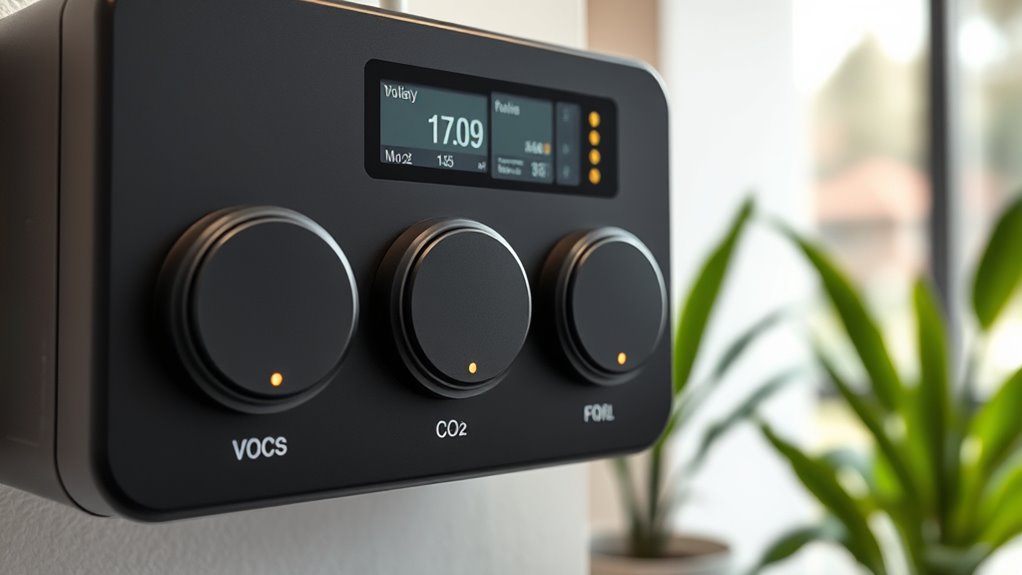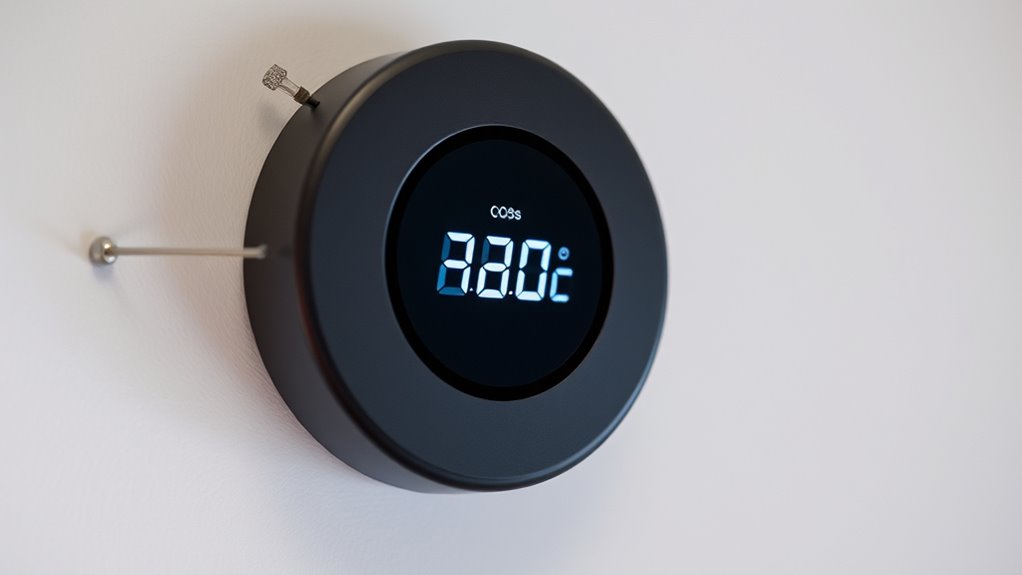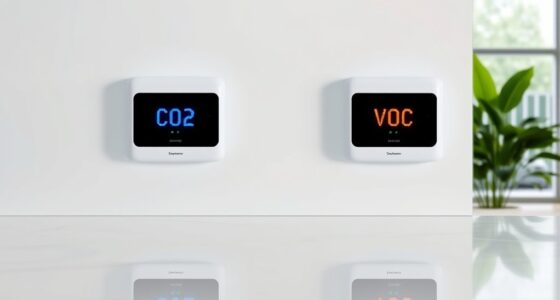When choosing air quality sensors, consider your main goals: VOC sensors detect harmful chemicals like paints and cleaning products, CO₂ sensors help optimize ventilation and comfort, and particulate sensors monitor dust, smoke, and allergens. Each sensor type serves a specific purpose, and combining them provides an all-encompassing view of indoor air. Proper calibration, sensitivity, and maintenance are key. To better understand which options fit your environment, continue exploring these sensor types in detail.
Key Takeaways
- Assess the specific pollutants of concern (harmful chemicals, CO₂ levels, airborne particles) to select the most relevant sensor type.
- Consider sensor sensitivity, detection limits, and calibration requirements to ensure accurate and reliable air quality data.
- Evaluate maintenance needs and costs, especially for particulate sensors, which may require frequent cleaning or replacement.
- Use combined sensor setups for comprehensive monitoring, integrating VOC, CO₂, and particulate sensors for complete indoor air quality insights.
- Match sensor choice to application goals—ventilation control, pollutant detection, or allergen monitoring—for effective indoor air management.
Understanding VOC Sensors and Their Role in Indoor Air Quality

Volatile Organic Compound (VOC) sensors play a crucial role in maintaining healthy indoor air quality by detecting harmful chemicals that can off-gas from everyday items like paints, cleaning products, and furniture. Proper VOC sensor calibration ensures accurate readings, allowing you to monitor indoor air dynamics effectively. As VOC levels fluctuate with activities and environmental changes, regular calibration helps maintain sensor reliability. Understanding indoor air dynamics—how air moves and pollutants disperse—enables you to interpret VOC sensor data more accurately. This knowledge helps you identify sources of VOCs and take targeted actions, such as increasing ventilation or reducing product use. Additionally, using proper calibration techniques enhances sensor performance and ensures consistent, trustworthy data. Ultimately, well-calibrated VOC sensors empower you to create safer, healthier indoor environments by providing precise, real-time information on airborne chemical concentrations.
The Significance of CO₂ Sensors for Ventilation and Comfort

CO₂ sensors play a vital role in maintaining indoor air quality by providing real-time data on carbon dioxide levels. When used effectively, they help you optimize ventilation, making your space more comfortable and healthier. Plus, proper CO₂ monitoring can improve energy efficiency by reducing unnecessary airflow. Incorporating ethical hacking principles such as continuous monitoring can help detect sensor malfunctions or security vulnerabilities, ensuring reliable operation.
Maintaining Indoor Air Quality
Effective indoor air quality depends on proper ventilation, which can be challenging to maintain without the right tools. CO₂ sensors play a vital role in this process by helping you monitor indoor levels and guarantee adequate airflow. When CO₂ rises, it signals poor ventilation, indicating you need to bring in more outdoor air. Good air filtration systems work alongside these sensors to remove pollutants, but without fresh outdoor air, indoor air can quickly become stale and uncomfortable. Regularly checking CO₂ levels allows you to adjust your ventilation strategies, maintaining a comfortable environment while preventing indoor air quality from declining. Additionally, understanding the influence of family bonds and shared experiences can motivate ongoing efforts to create a healthier indoor environment. Ultimately, combining CO₂ monitoring with effective air filtration and outdoor air exchange keeps your indoor space healthy and comfortable.
Enhancing Energy Efficiency
Using CO₂ sensors strategically can substantially boost your building’s energy efficiency by optimizing ventilation. When you monitor CO₂ levels accurately, you can adjust ventilation strategies to provide adequate fresh air without over-ventilating, reducing unnecessary energy use. This targeted approach prevents energy waste associated with constant or excessive ventilation, leading to significant energy savings. By maintaining ideal CO₂ levels, you ensure a comfortable indoor environment while minimizing the load on HVAC systems. Implementing responsive ventilation based on real-time CO₂ data not only improves air quality but also enhances overall energy efficiency. This method allows you to balance occupant comfort with sustainable energy practices, making your building more eco-friendly and cost-effective. Additionally, understanding the contrast ratio of your ventilation system can help optimize airflow and maintain indoor air quality more effectively.
Particulate Matter Sensors: Detecting Dust, Smoke, and Allergens

Particulate matter sensors play a crucial role in detecting airborne particles like dust, smoke, and allergens that can affect your health and indoor air quality. These sensors help you monitor pollutant levels, enabling effective air filtration and allergen control. By accurately measuring particles, you can identify when filters need replacement or when air circulation needs improvement. This proactive approach ensures cleaner air and reduces allergy triggers. Particulate sensors are especially useful in environments with high dust or smoke, providing real-time data to maintain a healthier living or work space. With such sensors, you gain better control over indoor air quality, preventing the buildup of harmful particles and creating a safer, more comfortable environment. In addition, understanding Volkswagen Tuning concepts can inspire innovative ways to optimize sensor performance and calibration for specific environments.
Comparing Sensor Sensitivity and Accuracy

When comparing air quality sensors, you need to consider their detection limits to guarantee they identify pollutants at relevant concentrations. Calibration consistency is also vital, as it affects how reliably the sensor reports accurate data over time. Understanding these points helps you choose sensors that deliver precise and dependable air quality readings. Additionally, selecting sensors with effective pet hair management features can help maintain sensor cleanliness and accuracy in environments with pets.
Sensor Detection Limits
Sensor detection limits play a pivotal role in determining how accurately air quality sensors can identify low concentrations of pollutants. These limits define the smallest amount a sensor can reliably detect, known as measurement thresholds. When choosing a sensor, understanding its detection limits helps guarantee it can monitor pollutants at levels relevant to health standards. Sensors with lower detection limits can detect pollutants at very low concentrations, providing early warnings and precise data. Conversely, higher detection limits might miss subtle changes, reducing effectiveness. Consider these points:
- Sensor detection limits vary between VOC, CO₂, and particulate sensors
- Lower measurement thresholds improve sensitivity
- High detection limits may overlook low-level pollution
- Match detection limits to your specific air quality requirements
- Advances in sensor technology are continually improving detection capabilities and accuracy.
Choosing sensors with appropriate detection limits ensures accurate, reliable monitoring of your environment.
Calibration Consistency
Calibration consistency is essential for ensuring that air quality sensors provide reliable and comparable data over time. Without it, sensor drift can cause readings to become inaccurate, affecting your data’s reliability. To prevent this, you need to follow strict calibration standards, regularly verifying sensor accuracy against known reference points. Consistent calibration helps identify and correct drift early, maintaining sensor sensitivity and precision. Using standardized procedures ensures that calibration remains uniform across devices and over time. This consistency is especially important when monitoring VOCs, CO₂, and particulates, where small deviations can lead to significant misinterpretations. Ultimately, regular calibration aligned with recognized standards keeps your sensors dependable, ensuring your air quality data remains accurate and meaningful for decision-making. Moreover, understanding the importance of sensor sensitivity and maintaining it through proper calibration is crucial for trustworthy air quality measurements.
Cost and Maintenance Considerations for Different Sensors

Understanding the cost and maintenance requirements of air quality monitoring sensors is essential for selecting the right equipment for your needs. Different sensors vary in sensor lifespan and replacement costs, affecting your long-term budget. For example, particulate sensors often need more frequent maintenance due to dust buildup, while CO₂ sensors typically last longer but may require periodic calibration. VOC sensors can be sensitive and might have higher replacement costs if they degrade quickly. Consider these factors:
- Sensor lifespan and how often replacements are needed
- Calibration and maintenance frequency
- Upfront purchase cost versus ongoing expenses
- Durability in your specific environment
- Awareness of regional divorce statistics can inform expectations regarding long-term investments in equipment, just as understanding local legal resources is crucial for effective representation.
Balancing initial costs with maintenance needs ensures you choose sensors that are cost-effective and reliable over time.
Application Scenarios for VOC, CO₂, and Particulate Sensors

Choosing the right air quality monitoring sensors depends heavily on the specific application scenarios you’re targeting. For industrial applications, VOC sensors are essential for detecting hazardous chemicals and ensuring worker safety. CO₂ sensors help monitor ventilation efficiency and indoor air quality, but they also have outdoor uses, such as evaluating urban pollution levels. Particulate sensors are critical in both outdoor monitoring—like tracking air pollution from traffic and industry—and indoor environments where dust, allergens, or smoke pose health risks. Outdoor monitoring stations often combine these sensors to provide thorough air quality data for public health advisories and regulatory compliance. Your choice hinges on whether you need to detect chemical contaminants, measure CO₂ levels, or track airborne particles, aligning sensor capabilities with your specific application needs. Additionally, understanding fetal development can inform the selection of sensors for environments where pregnant individuals may be present, ensuring safety and compliance.
Interpreting Sensor Data for Better Indoor Air Management

To optimize indoor air quality, interpreting sensor data accurately is essential for identifying pollution sources and taking effective action. Proper sensor placement ensures you capture representative data, avoiding false readings. Use data visualization tools to spot trends and anomalies quickly, making decision-making easier. When analyzing sensor data, consider:
- The location of sensors to detect high pollution zones
- Variations over time to identify patterns
- Correlations between different pollutants
- Sudden spikes indicating specific events or sources
This approach helps you focus on problem areas and optimize ventilation or filtration. Additionally, understanding the sensor calibration process ensures data accuracy for reliable decision-making. Accurate interpretation transforms raw data into actionable insights, empowering you to maintain healthier indoor environments efficiently.
Integrating Multiple Sensors for Comprehensive Air Quality Monitoring

Integrating multiple air quality sensors allows you to obtain a more thorough and accurate picture of indoor environments. Proper sensor placement is essential; position VOC, CO₂, and particulate sensors where airflow is representative and free from obstructions. This guarantees reliable data collection. Data integration plays a key role, as combining readings from different sensors provides a complete view of air quality. By correlating data, you can identify patterns and pinpoint pollution sources more effectively. Using a centralized system to analyze combined sensor outputs simplifies monitoring and decision-making. This approach helps you detect issues early, optimize ventilation, and maintain a healthier indoor space. Additionally, implementing automation can enhance real-time response to changing air quality conditions, further improving indoor environmental management. Overall, thoughtful sensor placement and seamless data integration enhance your ability to manage indoor air quality proactively.
Making the Right Choice Based on Your Environment and Needs

Selecting the right air quality sensors depends heavily on understanding your specific environment and monitoring goals. Consider where you’ll place sensors to maximize accuracy—high traffic areas or confined spaces may need different setups. Your needs also influence the type of sensor: VOC, CO₂, or particulate. Proper sensor placement guarantees reliable data and meaningful insights through effective data visualization. Think about the environment’s unique characteristics, such as ventilation or pollutant sources, when choosing sensors. For instance, particulate sensors work well in dusty settings, while VOC sensors suit chemical-heavy environments. Tailoring your approach helps you identify pollution hotspots and respond effectively. Additionally, understanding the typical pollutant levels in environments like water parks, which often feature outdoor and indoor areas with varying humidity and contaminants, can inform your sensor selection. Ultimately, aligning sensor choices with your environment and needs ensures you gather actionable data and maintain healthy indoor air quality.
Frequently Asked Questions
How Do Sensor Placement and Installation Affect Air Quality Readings?
Sensor placement and installation considerably impact air quality readings. You need to guarantee proper placement accuracy, avoiding areas near vents or windows that cause false readings. Regular sensor calibration maintains accuracy over time. Position sensors at breathing height and away from obstructions, so they reflect the actual air quality where people are. Proper installation and strategic placement help you get reliable data, enabling effective monitoring and decision-making.
What Are the Environmental Factors Influencing Sensor Performance?
Environmental factors like temperature, humidity, and airflow directly impact sensor performance. You should regularly calibrate your sensors to maintain data accuracy, especially in fluctuating conditions. High humidity can cause false readings, while temperature extremes can affect sensor sensitivity. Proper placement minimizes these issues, ensuring reliable data. By understanding and adjusting for these factors, you help your sensors deliver precise air quality readings essential for effective monitoring.
How Long Do Different Sensors Typically Last Before Replacement?
Imagine your sensors surviving a marathon—some last longer than you’d think. Typically, VOC sensors need replacement every 1-3 years, CO₂ sensors last about 5-10 years with proper calibration, and particulate sensors often require changing every 2-3 years. Regular sensor calibration is vital for lifespan optimization, ensuring your devices perform accurately and last as long as possible. Don’t forget, environmental factors also play a big role in longevity.
Are There Regulatory Standards for Indoor Air Quality Sensors?
You should know that regulatory compliance and certification standards guide indoor air quality sensors. While there aren’t universal laws mandating specific sensor types, many regions set standards to ensure accuracy and safety. Manufacturers often seek certifications like UL or CE to meet these standards. It’s your responsibility to select sensors that comply with local regulations, ensuring reliable readings and safe indoor environments.
Can Sensors Detect Multiple Pollutants Simultaneously?
You might wonder if sensors can detect multiple pollutants at once. Many modern air quality sensors feature sensor integration, allowing them to monitor VOCs, CO₂, and particulates simultaneously. This setup improves data accuracy by providing thorough insights in a single device. By choosing multi-pollutant sensors, you guarantee better indoor air quality management, reducing the need for multiple devices and streamlining your monitoring process effectively.
Conclusion
Choosing the right air quality sensors depends on your environment and needs. Whether you’re tracking VOCs, CO₂, or particulates, understanding their roles helps you breathe easier. Don’t forget, even in this age of modern technology, a well-chosen sensor is like having your own personal air quality knight—protecting you from unseen dangers. So, weigh your options carefully, and create a safer, healthier space that’s fit for a queen or king.









